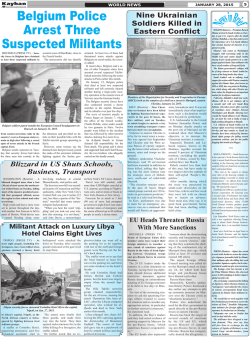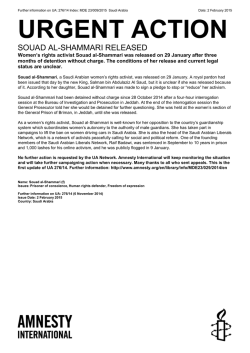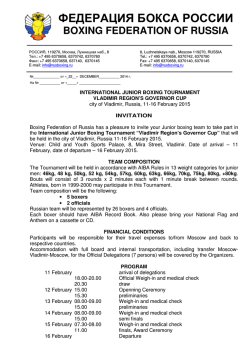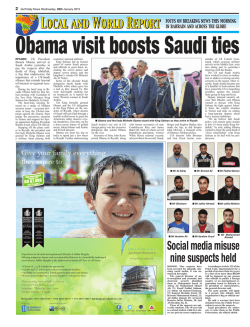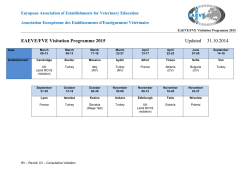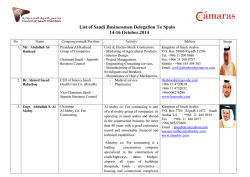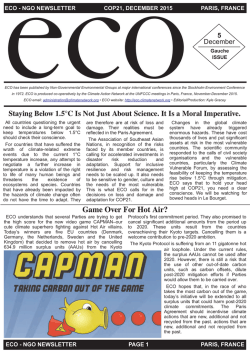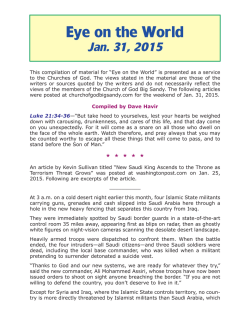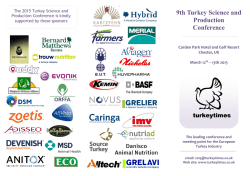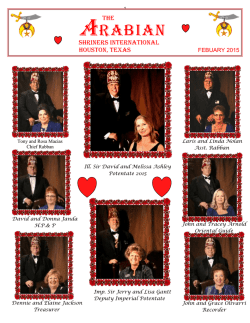
Challenges for European Foreign Policy in 2015
Challenges for European Foreign Policy in 2015 Futurology can take on different guises, particularly when trying to anticipate the problems Europe’s foreign policymakers will face in 2015. In this paper, FRIDE’s tack is to look at the shifting postures, concerns and priorities of nine regional powers and then propose a spectrum of ‘coping strategies’ for them to consider. By Giovanni Grevi for FRIDE 28.01.2015, ISN Zurich (Switzerland) http://www.isn.ethz.ch/Digital-Library/Articles/Detail/?lng=en&id=187291 This is the introduction to „Challenges for European Foreign Policy in 2015: How others deal with disorder” by Giovanni Grevi and Daniel Keohane (eds.), originally published by FRIDE on 12 January 2015. At no time since the end of the Cold War has the world been more prone to disorder and insecurity. This poses huge challenges for the European Union (EU) and its member states. Europe faces geopolitical confrontation with Russia to the east, a crumbling regional order to the south and growing tensions in East Asia. But Europe is not alone in feeling geopolitical stress. Many regional and global powers share vulnerability to spreading instability, and uncertainty about how to address it. The narrative of Europeans scrambling to find their way in a competitive multi-polar system while others, notably emerging powers, shrewdly pursue their objectives is misleading. Uncomfortable powers and the paradox of assertiveness This FRIDE annual publication looks at how a select range of powers perceive and manage disorder in the Middle East, Eurasia and East Asia. It finds that, despite often bold rhetoric and some daring moves, few if any of them are confident in their ability to manage threats to their security. In fact, to different extents and for different reasons, they all feel rather uncomfortable and exposed to geopolitical challenges and trans-national risks. Conversely, none of these powers seems willing or able to offer lasting solutions to the problems they face. The capacity of the United States (US) and Europe to stabilise regional crises is still considerable in relative terms, but is often not used effectively (consider Libya or Syria) and is on the wane. The strategic focus of most other countries largely lies on their respective neighbourhoods, whether to contain regional threats (India and Turkey), assert primacy (Russia and China) or ensure regime survival (Saudi Arabia and Egypt). The paradox is that uncomfortable powers often try to cope with tensions or instability by taking assertive steps that ultimately exacerbate their own and others’ insecurity. Russia’s annexation of Crimea in March 2014 and the role it has played since in Eastern Ukraine are a text-book case of this approach. But this paradox also applies to, for example, China’s assertive moves in the East and South China Seas, engendering confrontation with other insecure regional powers. Yet another instance is the apparently audacious but ultimately self-defeating manoeuvrings of Saudi Arabia and Iran in an explosive Middle East. A world of uncomfortable powers is a dangerous one, because they tend to be reactive actors, with all the potential intended or unintended consequences that this entails. Disorder management strategies The principal architect of the international system – the US – is exploring a more selective and restrained approach to managing disorder. The ongoing ‘rebalancing’ of American strategic assets from Europe and the Middle East to the Asia-Pacific has been affected, but not stopped, by renewed turmoil in the first two regions. In any case, Washington’s ‘rebalancing’ to the Pacific has never been about giving up US influence in Europe and the Middle East, but exercising it in more indirect and less demanding ways – such as greater diplomatic engagement, depending on (and helping build) the capacities of partners and very targeted military involvement. However, there are serious doubts that this ‘light footprint’ will suffice to contain conflicts (and the instincts of friends and foes) in the Middle East. Simultaneously, the US is conscious of the need to strike a delicate balance between confrontation and engagement towards ‘revisionist’ competitors Russia and China. Both of them challenge American preeminence, but they are critical to managing key issues such as the Iranian and Afghan files and for the stability of Europe and Asia. Beyond some tactical convergence, for example on energy deals, the strategic postures of Russia and China differ considerably. Russia responds to threats with the stark reassertion of its great power status. For the Kremlin, attack appears to be the best form of defence to counter what it sees as Western moves to weaken Russia. To this end, Moscow has deployed a complex strategy including military interventions, leveraging its influence in protracted conflicts, a mix of hard and soft power to keep neighbours in line, and regional integration initiatives. However, Russia appears to have few real friends and the pillars of its power, including a stuttering economy, are relatively weak. China is in a stronger position and has so far shown more restraint than Russia. But in its own eastern neighbourhood China has grown more assertive, testing the resolve of its opponents in territorial disputes in the East and South China Seas and, indirectly, the will and capacity of the US to back them up. Beijing feels that time is on its side and resents what it perceives as a USdriven attempt to build networks and frameworks to contain it. China is, however, much less confident when it comes to defending its growing (energy and economic) interests in distant unstable regions such as the Middle East and Africa. While upholding the principle of nonintervention, it has actually long relied on Western power to keep crises there in check. In fact, Beijing worries that Western ability to perform this stabilising role in the Middle East and Africa is diminishing. Concerned with the spread of extremist networks in its western regions, China may gradually step up its role to manage disorder, for example in Afghanistan and parts of Africa. Like in the case of China, the immediate neighbourhood takes centre stage in India’s threat perception. On top of its long-standing rivalry with Pakistan, India thinks China is trying to undermine its regional influence. India responds to these challenges with hard and soft power (from nuclear deterrence to aid to fragile neighbours). Delhi is also establishing security partnerships with a range of countries from Asia to Europe and the US. These are mainly directed at dealing with threats stemming from Pakistan, keeping China’s power in check, and strengthening Delhi’s hold on the Indian Ocean. India’s economic and energy interests in the Middle East and Africa are growing rapidly. But while Delhi has long contributed to stability in Africa, mainly though United Nations (UN) peace-keeping operations, it has essentially outsourced the management of Middle Eastern disorder to the US and Europe. Squeezed between China and Russia, Kazakhstan epitomises the dilemmas of a vulnerable middle power in a fiercely competitive environment. Kazakhstan suffers from the confrontation between Russia, the EU and the US, and feels the heat as the Kremlin tightens the screws on former Soviet republics. Kazakhstan has sought to respond to these and other challenges through a strategy of ‘zero problems and many friends’, diversifying its partnership portfolio to include Russia and China as well as the West in a permanent balancing act. In an even tougher regional context, Saudi Arabia and Egypt are confronted by multiple threats to the survival of their respective regimes. Both Riyadh and Cairo leverage regional threats such as terrorism to legitimise their authoritarian rule at home and abroad. While broadly aligned, their approaches to mounting insecurity do not coincide. Under the military regime that seized power in 2013, Egypt has reverted to a foreign policy directed at preserving the regional status quo and pursuing its traditional role as mediator in the Israeli-Palestinian conflict. While joining forces with Saudi Arabia and the United Arab Emirates (UAE) to counter extremist networks in Libya and Syria, Egypt does not favour the demise of the Assad regime. Saudi Arabia has taken a more assertive approach to regional turmoil in an attempt to contain the aftershocks of the Arab uprisings and to balance Iran, not least by supporting the Syrian opposition to pro-Iran Assad. Both countries consider the US to be a less dependable partner than before. They have therefore sought to build other partnerships, whether by setting up coalitions with other Sunni countries in the case of Saudi Arabia, or by increasingly relying on Saudi and Emirati financial support, while warming up to Russia, in the case of Egypt. Turkey is surrounded by trouble to the north and to the south and takes a disjointed approach to the two regions – caution and restraint on the crisis in Ukraine and active engagement in the Middle East’s crises. Turkey is trying to play a balancing act towards Russia, protecting its economic and energy interests while seeking to contain Moscow’s clout in the Caucasus. Ankara has positioned itself as a leading supporter of the Arab uprisings and in particular of the Muslim Brotherhood, while opposing the Assad regime in Syria. This disjointed strategy has resulted in Turkey losing ground in both theatres. Russia challenges Turkey’s influence in their shared neighbourhood, while Ankara faces the antagonism of Saudi Arabia, Iran and Sisi’s Egypt in the Middle East. Iran has extended its influence in destabilised Iraq and Syria. While countering the West, Turkey and Saudi Arabia in supporting the Assad regime, it is drawing geopolitical dividends from its de facto alignment with the US-led coalition against the Islamic State (IS). Tehran has shifted its posture from revolutionary power to leader of the Shia camp in the competition for regional hegemony with Riyadh. It has shown a degree of self-confidence in dealing with regional threats and carrying out nuclear negotiations with the P5+1. However, Iran remains vulnerable to reversals, and relations with some Kurdish organisations within and outside the country may grow tenser during 2015. Implications for Europe The picture emerging from this review of how other powers are managing disorder is sobering for Europeans. In many cases, the strategic focus of key powers is narrow and their posture adversarial. There is little appreciation that achieving real stability requires meaningful dialogue and joint efforts. And yet, none of the powers reviewed in this book, with the partial exception of China and perhaps Iran, feels more confident or secure than it did a few years ago. The limitations of a strategy of self-reliance and short-term gains are increasingly apparent. This will not translate into sustained cooperation to manage regional tensions or crises any time soon. The challenge is to incrementally create the conditions for a change of paradigm in respective regions, while preventing further destabilisation. During 2015, protecting European security will often require helping others improve theirs. This FRIDE annual publication suggests that Europeans need to broaden their strategic horizon. In particular, they should frame their partnership with the US as a global endeavour to support international stability, from the EU’s neighbourhood to East Asia. At the same time, both Brussels and Washington will need to devise creative approaches to dealing with pivotal countries that are both competitors and partners. Brussels will have to increasingly practice a ‘segmented’ foreign policy with a range of important countries: joining forces or offering support where interests are shared; accepting that sometimes there is little common ground; and taking firm stances to criticise or counter actions where interests diverge. The crisis in Ukraine and its reverberations will remain the defining issue for European foreign policy in 2015. While responding firmly to further attempts to destabilise Ukraine, Brussels should seek to pursue cooperation with Moscow where interests converge, which may pave the way to re-starting a broader dialogue down the line, if there is mutual interest. At the same time, the EU will have to seriously re-think its political approach to the eastern neighbourhood – an effort to which Turkey could usefully contribute. In the Middle East, Europe has lost influence regarding not only Turkey but also countries like Saudi Arabia and Egypt. They have chosen their own ways to deal with disorder, and their records are very mixed, at best. The EU and its member states could play a useful role in lowering tensions around the intractable Syrian conflict and the broader contraposition between Saudi Arabia and Iran. In particular, they could help sell a possible nuclear deal with Iran to highly sceptical neighbours. Building on progress on the visa liberalisation roadmap, Turkey may be interested in cooperating with the EU on the root causes of instability in its neighbourhood. The EU should also promote and seize opportunities for cooperation with China and India on crises in the Middle East and Africa. The two Asian giants will be of little help regarding Russia, but are aware of the risks threatening their growing interests in these other unstable regions and have begun to step up their involvement, notably in Africa. A big question during 2015 (and beyond) will be whether China and India will seek to play a more tangible and constructive role in addressing the crises shaking the Middle East and whether this will offer scope for cooperation with Europe. For more information on issues and events that shape our world, please visit the ISN Blog and browse our resources. Giovanni Grevi is director of FRIDE, where he worked as senior researcher and head of the Brussels office since 2010. Editor's note: This is the introduction to „Challenges for European Foreign Policy in 2015: How others deal with disorder” by Giovanni Grevi and Daniel Keohane (eds.), originally published by FRIDE on 12 January 2015.
© Copyright 2025
